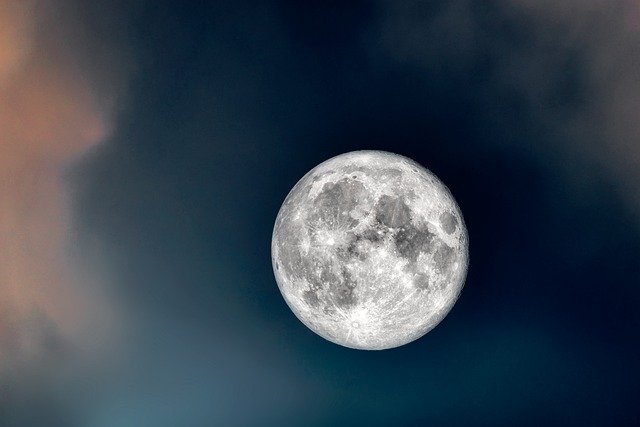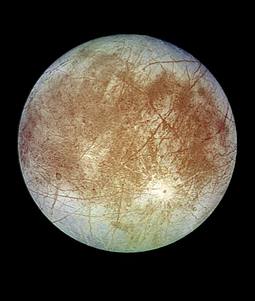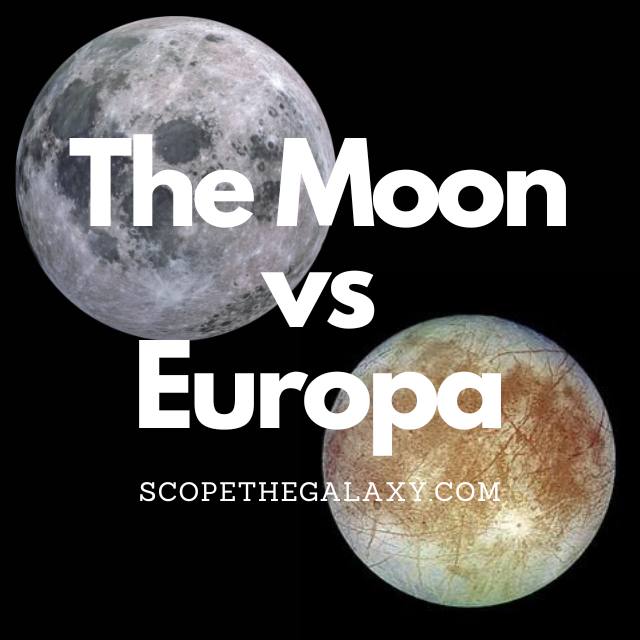*This post may contain affiliate links. This means we may make a commission if you purchase an item using one of our links*
The main differences between the Moon and Europa is that the Moon is Earth’s only natural satellite and is the 5th biggest moon with a diameter of 3474.8km whilst Europa is the smallest Galilean moon but is still the 6th biggest natural satellite with a diameter of 3,121.6km and Europa’s surface is mostly water ice whereas the moon’s surface is mostly igneous rocks.
There are numerous other differences between the two so, continue reading for a more detailed look at each entity below along with the similarities and differences they have.
What Is The Moon?
Table of Contents

The moon is the gray celestial being that orbits our Earth. It is also tidally locked to Earth meaning that we only see one side of it at any time in our sky.
It takes the moon roughly 27 days to complete an orbit around Earth, which it does in an elliptical pattern. The Moon’s axial tilt is very straight at 1.5 degrees. As a result of the tidally locked status along with the effects that Earth has on its general rotational patterns, it takes the Moon roughly 29.5 days to complete a day.
In regards to its temperature, it fluctuates where it can be really hot at 127 degrees Celsius when the Sun is shining on it and to -173 degrees in areas where the Sun does not strike it. It’s core on the other hand is far hotter ranging between 1,327 to 1,427 degrees Celsius.
This is as a result of the lunar entity’s extremely thin to practically non-existent atmosphere, which not only results in these massive temperature shifts but, is also the reason why it has over 100,000 craters on its surface.
Speaking of the Moon’s surface, the entity is mostly made of rocks, iron, magnesium just like most of the other moons and terrestrial based planets in our solar system.
It is among the bigger moons in our solar system with a diameter of 3,474.8km and a mass of 7.35 × 10^22 kg, which actually places it fifth amongst all moons in our solar system and would also make it bigger than the dwarf planet Pluto.
Despite all the advancements in technology, the last time a manned mission was made to the Moon was on the Apollo 17 way back in December 1972 and no further missions have been done since, possibly as result of the political agendas behind the numerous countries vying for opportunities that we don’t know of.
What Is The Moon Europa?

Europa is the smallest of the Galilean moons, first discovered on 8th January 1610. The surface of this icy world is frozen, but scientists believe a watery ocean could lie beneath the surface. And in 2012, researchers found a possible water plume in the Southern polar region of Europa.
This research is yet to be confirmed; still, it gives us reasonable grounds to hypothesize that water could exist on this icy moon.
Estimates place Europa at around 4.5 billion years old (the same age as its planet, Jupiter), and its average distance from the Sun is approximately 780 million km.
It has a diameter of 3,121.6km, which makes it larger than Pluto but smaller than the Earth’s moon, and the maximum temperature is a chilly -160 degrees Celsius. In regards to mass, it measures in around 4.8 × 10^22 kg.
Europa takes three-and-a-half days to orbit its planet at an average distance of 670,900km, and it is tidally locked, meaning the same side of the moon always faces Jupiter.
Among the fascinating features of this ice moon is its incredibly reflective nature. The icy crust of this body provides a light reflectivity of 0.64 – the highest of any moon in the solar system.
Data from the Galileo spacecraft suggests that Europa is composed of an iron core, rocky mantle, and silicate rock (a similar composition to Earth).
The moon’s surface is covered in cracks, which many theorize could result from tidal currents beneath the surface. It is this potential of water – and of life – that keeps astronomers so interested in this moon.
Europa might be small, but astronomers estimate it holds two to three times more water than the Earth. In addition, this moon possesses the essential elements for life, such as carbon, oxygen, hydrogen, and nitrogen.
There may be no solar energy on this moon, but hydrothermal vents could provide energy, and tidal heating from Jupiter could provide a heat source and keep the moon stable enough for life to form. In addition, the liquid ocean is well protected from radiation from thick, icy surfaces.
How Are The Moon And Europa Similar?
As both are natural satellites, the Moon and Europa do share a few similarities, which includes the following:
- Both have a hotter central core.
- Both have a rocky, terrestrial surface.
- Both are spherical in shape.
- Neither have rings surrounding them.
- Both are tidally locked to their planet.
- Both orbit their planet in an elliptical pattern.
- Neither have tectonic plates.
- Neither have a magnetosphere.
Differences Between The Moon And Europa
In regards to the differences between the two, they would include the following:
- The Moon is the 5th largest natural satellite in our solar system with a diameter of 3,474.8km whilst Europa is the 6th biggest Moon with a diameter 3,121.6km
- Europa is Jupiter’s 4th biggest moon whilst the Moon is Earth’s only natural satellite.
- Europa’s surface is made of water ice whilst the Moon is made mostly of igneous rock.
- A day on the Moon takes 29.5 days to complete whilst a day on Europa would take 3.5 days.
- It takes the Moon 27 days to orbit Earth whilst Europa orbits Jupiter in 3.55 days.
- Europa’s distance from Jupiter is 670,900km on average whilst the Moon’s average distance is 384,400km.
- The Moon has an axial tilt of 1.5 degrees whilst Europa’s is 0.1 degrees.
- The Moon’s temperature ranges between 127 degrees Celsius to a chilly -173 degrees Celsius whereas Europa’s average temperature is -160 degrees Celsius.
- Europa has the highest reflectivity of all the moons in our solar system where its reflectivity is 0.64 whereas the Moon’s reflectivity is 0.12 in comparison.
- Europa’s density is 3.01 g/cm³ whilst the Moon’s is 3.34 g/cm³.
- The Moon’s gravity is 1.62 m/s² whilst Europa’s gravitational strength is 1.315 m/s².
- In regards to mass, Europa’s is 4.8 × 10^22 kg whereas the moon is slightly bigger at 7.35 × 10^22 kg.
Summary
Overall both are natural satellites and share a fair few things that natural satellites would such as the fact they orbit a planet and are tidally locked to said planet.
But, they still differ in variety of other ways, whether it be size, temperature, the activity on their surfaces, their gravitational strength and more.

